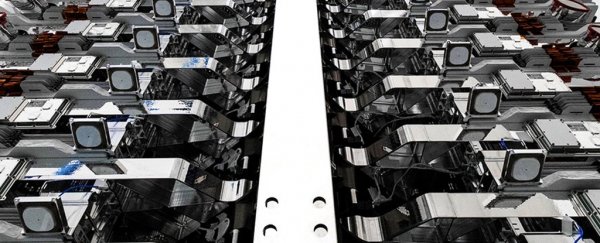SpaceX is on course to rocket tens of thousands of satellites into Earth's orbit, part of Elon Musk's plan to blanket the planet in high-speed internet. For the first time, data shows that the company may be able to accomplish this feat without marring everyone's view of the night sky.
When the first bright trails of the company's Starlink satellites paraded across the night in May 2019, scientists feared that it was a preview of a future in which points of moving light swarm the skies and overshadow the stars.
But Starlink may now be largely invisible to the naked eye, according to a new analysis. The paper suggests that new sun-visors added to the most recent 415 satellites SpaceX has launched may have significantly darkened them.
The visors deploy after launch and block sunlight from reflecting off the satellites' shiniest surfaces.
These "VisorSats," as SpaceX calls the satellites with this built-in feature, are on average 31 percent as bright as the 540 Starlink satellites that came before them, according to the paper.
The research, which was based on 430 observations of satellites flying overhead, was published Saturday on the open repository ArXiv.
However, this visor improvement still leaves the satellites about 2.5 times brighter than SpaceX's goal, and they're still far too bright for telescopes to be unaffected. The visors probably won't prevent Starlink from permanently changing ground-based astronomy.
"It's a win, but not a complete victory," Jonathan McDowell, an astronomer at the Centre for Astrophysics at Harvard and Smithsonian, told Business Insider.
"It's a win for the worry about changing the night sky for the average person," he added. "I think we've avoided that fate."
But for telescopes, the skies could still be swarming with false stars in just a few years, making it nearly impossible to get a clear look at the cosmos. That could hamper efforts to study celestial bodies and protect the Earth from deadly asteroids.
SpaceX has launched more than 950 Starlink satellites into Earth's orbit over the last two years. Early iterations of the internet service have provided broadband-like performance in rural America.
The company has permission from the Federal Communications Commission to rocket 12,000 satellites into orbit by mid-2027. Its filings suggest a long-term plan involving 42,000 spacecraft; 20 times the total number of working satellites pre-Starlink.
SpaceX did not respond to a request for comment and has not shared its own data on the VisorSats' brightness.
Starlink satellites are photobombing telescope observations
In the new analysis, engineer Tony Mallama calculated that the visored Starlink satellites have a magnitude, or brightness, of 5.92. This means that under certain conditions, you could still see them with the naked eye.
"In most circumstances, even in fairly dark sites, they're going to be just below naked-eye visibility; or most of them are," McDowell said.
SpaceX has said its minimum goal is to get the satellites to magnitude 7, which would be more than 2.5 times darker than they are now and well below naked-eye visibility.
But even then, Starlink could still photobomb telescope observations and ruin astronomers' data.
A single satellite can create a continuous streak of light across a telescope's long-exposure images of the sky, blocking the objects astronomers want to study. Satellites can especially affect telescopes that observe objects close to the horizon near dawn; and those are the observations that help astronomers track asteroids flying close to Earth.
"Some projects really won't mind this. Other projects we'll have to really rethink, and some will be impossible," McDowell previously told Business Insider.
Satellites also broadcast radiowaves and emit invisible wavelengths of light, like infrared. That can interfere with telescopes that use those waves to observe the Universe.
Even for Earth-orbiting space telescopes like Hubble, the satellites may frequently streak across a field of view and ruin hard-won images of deep space.
"We're in a new phase of space utilization. It's a new space industrial revolution, things are different, and astronomy's going to be affected," McDowell said in August.
"We just have to make sure we're part of the conversation so we can keep it down to the 'pain in the neck' level and not the 'give up and go home' level."
Satellite regulations don't take astronomy into account
Musk has said the Starlink service could eventually fund SpaceX missions to Mars. But the company isn't the only one planning a constellation of satellites.
Companies like Amazon and OneWeb aim to establish their own fleets of thousands of satellites, and a Chinese company called GW has filed a proposal to launch a constellation of nearly 13,000 satellites.
McDowell is particularly concerned about OneWeb, which has proposed sending its satellites to a much higher altitude than Starlink. That would make them visible for longer portions of the night. If that project goes forward as planned, McDowell said, it will be "pretty impossible" to do most ground-based observations during the summer.
OneWeb satellites will appear about as bright as SpaceX's VisorSats, according to Mallama's analysis.
The FCC, which authorizes the flight and use of internet satellites in the US, has said that preventing disruption to astronomy is "not a condition" for licensing.
McDowell said he would like to see the FCC, the Federal Aviation Administration, and the United Nations hammer out satellite regulations that would take such impacts into consideration.
"There's some relief that, yeah, they did manage to make their Starlinks a little less bright. And that was nice that they chose to work with the community, " McDowell said.
"But it doesn't take away the need for a more regulatory approach; a global regulatory approach."
This article was originally published by Business Insider.
More from Business Insider:
